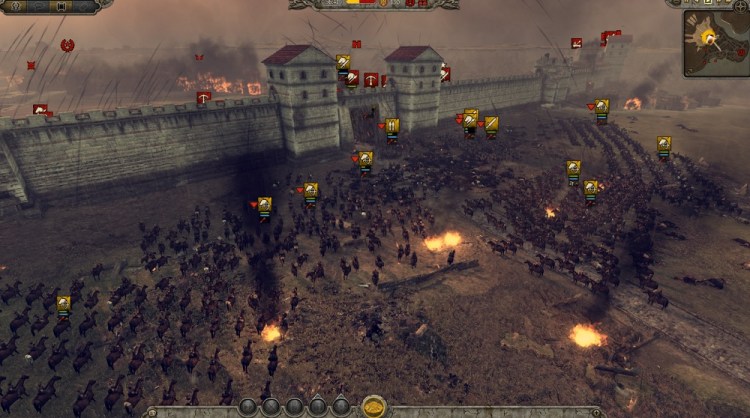What you won’t like
The A.I. can still do dumb things
When you play a campaign for five years, you may fight scores of battles. And during those battles, you’ll see the enemy A.I. do some dumb things. Most of the time, the A.I. is really good. It does things like try to break the siege of a city using a secondary army. But I watched dumbfounded as two A.I. cavalry units just wandered around a riverfront while the rest of the A.I. army was in a pitched battle. I can also tie up a lot of A.I. units by sending a single cavalry unit out to attack the rear of the enemy army. It’s a great trick to draw off a lot of A.I. units from the heart of the battle.
The slow sweep of turns
Back with the 2013 launch of Rome II, I complained that the changing from one turn to the next is a lot like the Civ games. It hasn’t changed. The faster your computer, the faster the game will compute all of the A.I. moves from dozens of factions that are active at any given time. As you move later in the campaign, it seems to take forever to execute and finish the turns.
After you end your turn, every faction has to make its move. And because many of these turns could be relevant to you, Attila tries to graphically show you what many of the visible factions are doing. This is a necessary but wasteful part of the game. Creative Assembly still hasn’t quite figured out how to process those moves in the background while you’re still able to do something useful within the game. Of course, if they did try to entertain you during the turn change, it might prolong the time it takes.
I played the title on a fairly hefty PC, with a 3.2-gigahertz Intel Core i7 CPU, 12 gigabytes of main memory, and dual GeForce GTX 680 graphics cards and 4 gigabytes of graphics memory on a Windows 7 machine. Still, the turns were still a little slow. But for the most part, the game ran fine in real-time battles, where it counts most. And it was easy to cruise through the big map of Europe without a slowdown.
The economy still won’t keep up with your ambitions
This is a problem that the series has had for years. When I played the Western Roman empire, I was clearly in charge of a bankrupt empire. But the lack of funds was a little too severe. I couldn’t even build a couple of farms in two cities without running out of funds in a turn. When you have dozens of cities under your control, you can see that your money won’t keep up with your desire to spend it.
This paralyzes you. Your ability to recruit soldiers depends on how well you manage the economy. And it’s hard to tell exactly how much you should be investing in it versus your military might. I started out in a deceptive state, where no one was revolting or bugging me about money. But the vultures came fast. First, I got attacked on all sides and couldn’t spend money to replace troops. Then the citizens began to starve and they revolted, in one city after the next.
I still feel like Creative Assembly needs to deliver a better picture of the state of affairs of the whole empire’s economy, and where you really can make enlightened choices about how to manage it. We’re in the age of cool dashboards and analytics. That may seem out of place in a game about ancient warfare, but I still feel like I could use more help figuring out what’s going on in the empire. For instance, I’d like to know which cities are going to riot and rebel next. When I look at the dashboard, it looks like everybody is going to go nuts.
Conclusion
As with Rome II, the positives outweigh the annoyances. Creative Assembly has been very ambitious with Total War: Attila, and the game is a lot more compelling than its predecessor. It feels more balanced. The A.I. is smarter, but a human general can still beat it. But the unrelenting weight of a collapsing empire pushes a human ruler to the limit. If you simply survive for a while, you’ll feel like you’ve won the game.
I think that hardcore gamers — including any fans of the Total War, Civilization, and Age of Empires games — are going to love this title. It has an appropriate teen rating, but you’ll find that it’s worth bringing the kids over to show them a cool battle or city. I can easily see someone sinking hundreds of hours into all aspects of the game. I keep coming back to this franchise because it lets me see the strategic high points of running an empire, and also see the gritty tactical horrors of the battlefield up close. The pitched battles go back and forth, but my interest in this franchise never wanes.
Score: 88/100
Total War: Attila will be released on Feb. 17 on the PC. The publisher provided GamesBeat with a download code for the purpose of this review.
Total War: Attila requires a Windows Vista or newer system, with 3 gigabytes of RAM, an Intel Core 2 Duo at 3 Gigahertz, and 35 gigabytes of free hard disk space. For graphics, you need to have a 512 MB NVIDIA GeForce 8800 GT card or better, or an AMD Radeon HD 2900 XT or Intel HD 4000.
VentureBeat's mission is to be a digital town square for technical decision-makers to gain knowledge about transformative enterprise technology and transact. Learn More





